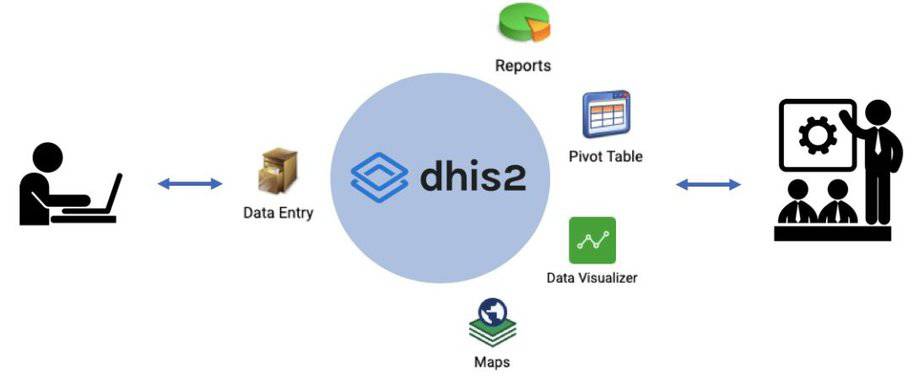In the world of healthcare, data is the driving force behind informed decisions and effective interventions. Efficient data management and analysis are crucial for effective decision-making and the successful implementation of health interventions. DHIS2, a dynamic platform, not only collects and manages health data but also serves as a catalyst for transforming data into action. In this blog, we’ll explore the pivotal role of DHIS2 in the journey from data collection to meaningful interventions that strengthen healthcare systems and improve public health outcomes.
DHIS2 (District Health Information Software 2) is an open-source software platform that is designed for the collection, management, analysis, and visualization of health-related data. It is widely used by governments, international organizations, and NGOs in public health and healthcare management fields.
The Role of DHIS2 in Strengthening Health Interventions
- Empowering data-driven decision-making: Health interventions are most effective when they are informed by accurate and up-to-date information. DHIS2 provides a comprehensive platform for collecting various types of health data, from patient information to disease prevalence and healthcare utilization. This data becomes the foundation for evidence-based decision-making. Health professionals can analyze trends, track progress, and identify gaps, enabling them to make informed choices.
- Tracking disease outbreaks and trends: In the realm of public health, the ability to track disease outbreaks and trends is paramount. DHIS2’s data analysis and visualization tools allow for the early detection of potential outbreaks, enabling rapid responses to contain and mitigate the spread of diseases. By identifying patterns and correlations within the data, health organizations can predict the emergence of health crises and allocate resources more effectively.
- Enhancing collaboration and coordination: Health interventions often involve collaboration between multiple stakeholders, including government agencies, NGOs, and international organizations. DHIS2’s data sharing and collaboration features bridge the gaps between these entities, facilitating information exchange and promoting coordinated efforts. This ensures that everyone involved has access to the same accurate and up-to-date data, fostering synergy in the implementation of interventions and avoiding duplication of efforts.
- Resource allocation and optimization: One of the most significant advantages of DHIS2 is its ability to facilitate targeted resource allocation. By analyzing data on disease prevalence, healthcare utilization, and other key indicators, health officials can pinpoint areas of high need. This data-driven approach ensures that resources, whether it’s medical supplies, personnel, or funding, are directed where they are most urgently required.
Case Studies: DHIS2 in Action
Let’s delve into a couple of real-world examples that highlight the transformative impact of DHIS2 in strengthening health interventions:
- Vaccination Campaigns: DHIS2 has played a crucial role in tracking vaccination coverage rates across regions. Health officials can identify underserved areas and launch targeted vaccination campaigns to improve immunization rates and prevent outbreaks.
- Maternal and Child Health Programs: DHIS2 enables the monitoring of maternal and child health indicators, ensuring that interventions are effectively reducing maternal mortality, improving child nutrition, and enhancing overall maternal and child well-being. An example is the World Health Organization – Maternal and Perinatal Database for Quality, Equity and Dignity (WHO MPD-4-QED) program that was implemented by WHO, in collaboration with eHealth4everyone to improve overall maternal and child well-being by monitoring key health indicators in Nigeria.
In conclusion, the journey from data collection to action is where the true value of DHIS2 becomes evident. It empowers decision-makers with the insights needed to make informed choices, allocate resources strategically, and implement timely interventions that save lives and enhance the health of communities.
DHIS2 is not just a data management platform; it’s a catalyst for positive change in public health systems. By leveraging its capabilities, health organizations can bridge the gap between data and action, creating a more responsive, effective, and resilient healthcare system that makes a tangible difference in people’s lives.
External Links
- https://journalofbigdata.springeropen.com/articles/10.1186/s40537-019-0217-0
- https://dhis2.org/about/
- https://bmcpublichealth.biomedcentral.com/articles/10.1186/s12889-023-15979-z
- https://www.openhealthnews.com/articles/2017/developing-nations-improving-health-communication-through-use-dhis2-part-1
- https://www.cambridge.org/core/services/aop-cambridge-core/content/view/6229179C9F50D5642B1647E1A5FD1CE5/S1935789320003614a.pdf/optimizing-pandemic-preparedness-and-response-through-health-information-systems-lessons-learned-from-ebola-to-covid-19.pdf
- https://www.qualityofcarenetwork.org/sites/default/files/2021-06/MPD4QED_newsletter.pdf



